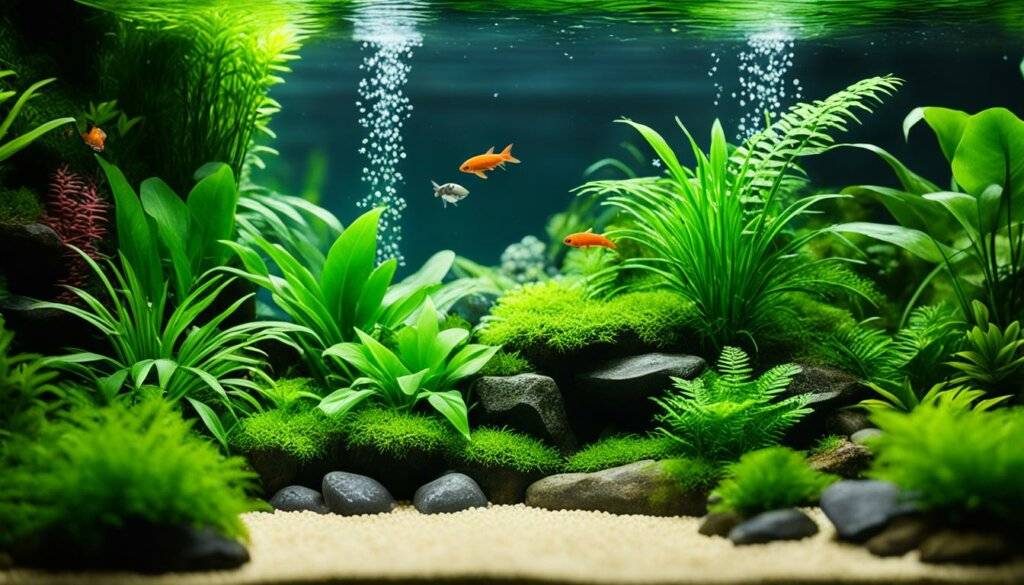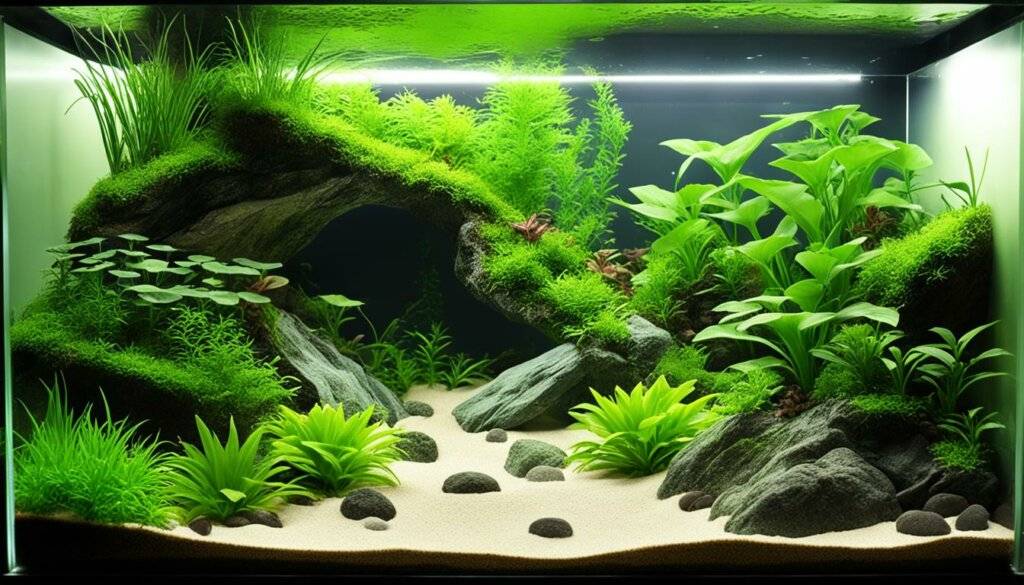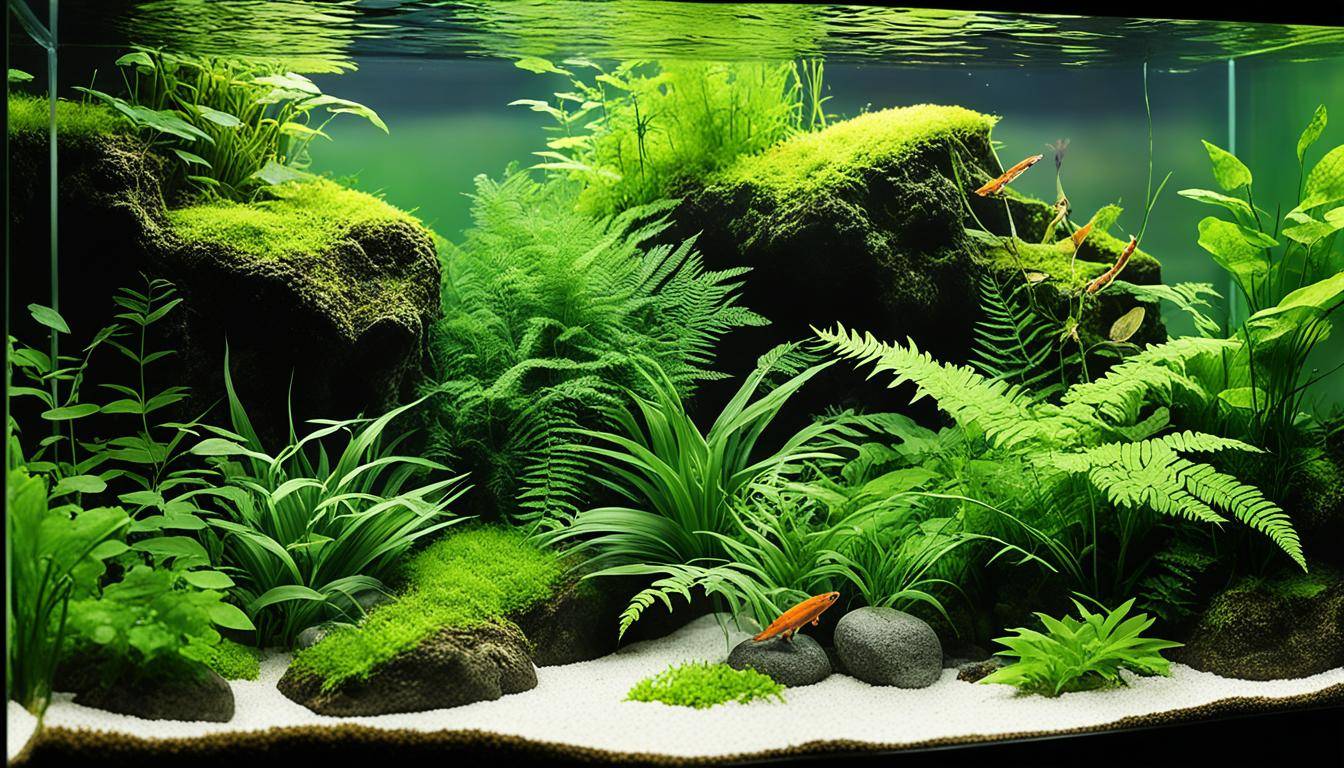Imagine a slice of nature in your home. You watch the beauty of fish swimming among green plants. This is the magic of paludariums.
They blend water and land environments into one amazing tank. It’s like having a little world at home.
What Is a Paludarium?
A paludarium mixes water and land, creating a unique ecosystem. It bridges the gap between aquatic and dry areas, like the space near a river. It’s perfect for plants and animals that love both water and land.
The balance in a paludarium is key. It has just the right mix of water and land. This setup lets different plants and animals live together happily.
Designing a paludarium lets you be creative. You can use rocks, driftwood, and plants to make different landscapes. This setup offers a beautiful home for your pets and a joy for anyone who looks at it.
“a paludarium provides a balanced environment for aquatic and terrestrial life.”
Aquatic Life in a Paludarium
A paludarium is great for all kinds of water creatures. You can have fish, amphibians, and even small invertebrates. The water area lets them live their natural lives, making it fun for you to watch them.
Terrestrial Flora in a Paludarium
The dry area is perfect for growing many plants. You can pick plants that love water or others that prefer it dry. These plants make your paludarium look vibrant. They also provide a place for animals to live and eat.
| Advantages of a Paludarium | Disadvantages of a Paludarium |
|---|---|
| Ability to create a more natural and realistic habitat | Requires more maintenance to ensure proper functioning of both water and land elements |
| Opportunity to observe the interactions between aquatic and terrestrial life | Potential challenges in regulating humidity levels |
| Provides a visually stunning and captivating display in any living space | Requires precise control of lighting and temperature to support diverse flora and fauna |
Paludarium vs Riparium: What’s the Difference?
Paludariums and ripariums both blend water and land. Yet, they cater to different types of species. A paludarium is more land-rich, perfect for creatures that like some land and some water. Meanwhile, a riparium has less land and is great for animals who love being fully underwater.
Ripariums don’t have any areas that are fully dry. Submersible plants are the key here. On the flip side, paludariums can have parts that are moist and others that are fully dry. This allows for a wider variety of both plants and animals.
| Features | Paludarium | Riparium |
|---|---|---|
| Land Area | Provides habitat for semi-aquatic animals | Smaller land area primarily supporting fully aquatic life |
| Dry Areas | Contains both wet and dry areas | No completely dry areas |
| Flora | Greater diversity of plants and animals | Flora consists of submersible plants |
Knowing the differences helps you pick the right home for your fish and plants. It’s a way to make sure they’ll be happy in their surroundings.
Building a Paludarium
Building a paludarium involves three key areas: the canopy, land, and water. Each plays a vital role in a balanced ecosystem. They create a perfect home for plants and animals.
The Canopy: Providing Shade and Security
The canopy is the top part of the paludarium, offering shelter and safety. It’s filled with plants like mosses and vines for a dense look. This top layer keeps the animals secure and gives them somewhere to hide.
The Land: Establishing Terrestrial Features
The land area brings the ground-dwelling part of the ecosystem to life. Here, you place rocks, soil, and wood to mimic a natural setting. It lets you grow a wide range of plants, from small grasses to big shrubs.
Choose plants that like both moist and dry conditions. They will fit well with the water nearby.
The Water: Creating an Aquatic Haven
Water is key in a paludarium, serving as a home for water-loving creatures. It also helps keep the place humid. The water area can be shallow or deep, depending on its use.
A good filter keeps the water clean. You can also add waterfalls or streams. Place aquatic plants like moss and lilies in these waters. They improve the water quality and offer hiding places.

-
Save
By planning the canopy, land, and water well, you make a fascinating paludarium. It mirrors nature with its combination of water and land life. This mix is both beautiful and a great learning experience for fans of nature.
Paludarium Substrate
In a paludarium, the substrate is key for plants and aquatic life. It forms the base of the ecosystem there. Picking the right one is crucial for a healthy paludarium.
Common choices for substrates are:
- Aquarium gravel
- Pebbles
- Rock pieces
- Aquatic soil
These should have a neutral pH. This helps plants and fish thrive. They also need to be easy to clean. A substrate full of nutrients boosts plant growth and ecosystem health.
Sand is a favorite for many paludariums. It looks natural and offers design flexibility. It makes a lovely home for water creatures.
Choose a substrate based on what your plants and animals need. Make sure it’s suitable for your paludarium.
Benefits of a Proper Paludarium Substrate
The right substrate does a lot for your paludarium:
- Plant Growth: It provides plants with the minerals they need to grow well.
- Root Development: Strong substrate supports plant roots for better health and stability.
- Biological Filtration: It’s a home for helpful bacteria that clean the water by breaking down waste.
- Aquatic Life Habitats: The right substrate creates natural homes for fish, with spots to hide and nest.
A good substrate is crucial for a thriving paludarium. It helps everything from the plants to the fish live well together.
| Substrate Type | Key Features |
|---|---|
| Aquarium gravel | Provides stability, easy to clean |
| Pebbles | Enhances filtration, aesthetic appeal |
| Rock pieces | Creates naturalistic landscapes, provides hiding spots |
| Aquatic soil | Nutrient-rich, supports plant growth |
| Sand | Provides natural-looking background, easy to modify |

-
Save
Choosing the right substrate is key. It helps create a healthy, beautiful space for life in your paludarium.
Paludarium Lighting
Good lighting is key for your paludarium’s health and growth. Using the right light helps your plants and animals thrive. It’s essential for a lively and colorful ecosystem.
Choosing the Right Lighting
Think about what your plants and animals need when choosing lighting. Various species need different light amounts and types. Some popular choices are:
Fluorescent Lighting: This type is energy-saving and offers a broad light spectrum. It suits both the water and dry areas, fostering healthy plant growth.
Incandescent Lighting: Incandescents create a warm, yellow light. They’re great for highlighting land spots. However, they might not help all plants grow.
Halogen Lighting: Halogens give off a bright, white light. They’re perfect for bringing out your paludarium’s colors. Use them for watery terrains and adding bright details.
Supplemental Lighting
At times, extra light is needed for your plants to grow well. This is useful if your setup doesn’t get enough sunlight. LED lights are a good choice for this. They’re efficient and offer flexible lighting options.
Lighting Schedule
Keep a regular light schedule to mimic day and night for your ecosystem. Most plants and animals need 10-12 hours of light daily. A simple timer can help keep the schedule and the health of your paludarium consistent.
Tips for Proper Lighting
For the best light, try these tips:
- Place your lights so they cover the whole space evenly.
- Be careful not to put the lights too close to your plants. Too much light can harm them.
- Remember to watch the lights’ temperature. They shouldn’t get too hot.
- Clean your lights regularly and change the bulbs when they wear out.
Here’s a picture of a well-lit paludarium to give you an idea:
| Lighting Type | Pros | Cons |
|---|---|---|
| Fluorescent | Energy-efficient, great for most setups, supports plant growth | May not be enough light for all plants |
| Incandescent | Creates a cozy feel, perfect for dry areas | Not ideal for all plants’ growth |
| Halogen | Shows off colors, suits water areas | Needs good ventilation due to heat |
Getting the right lighting is crucial for a healthy paludarium. With the right choice and care for your lights, you can have a beautiful, thriving ecosystem. This helps keep your plants and animals happy and well.
Converting Aquariums & Terrariums
Many people start with aquariums or terrariums and then turn them into paludariums. This means changing the setup from water to land, or the other way around. Usually, aquariums become paludariums by taking some water out to make more room for land. Terrariums already have ways to drain, making it simpler to mix water and land. When making this change, think about what the original setup can handle.
Turning an aquarium into a paludarium is like turning water gardens into lush lands. Lowering the water and adding plants, rocks, and soil makes it beautiful. This step lets you house more kinds of life, both in water and on land. It broadens your options for creatures and plants to keep.
On the flip side, changing a terrarium into a paludarium means adding water. Terrariums are usually dry, but they’re also easy to drain. You can put in a pond or stream and choose water plant and animals. This makes a vivid mix of water and land. The terrarium’s original setup helps a lot, making the process smoother.
‘Converting an aquarium or terrarium into a paludarium allows you to unlock the full potential of your enclosure, creating a captivating and dynamic environment that combines the beauty of aquatic life with the richness of terrestrial flora.’
When switching, think about what your new friends, the plants and animals, need. You’ll have to watch over the light, dampness, heat, and water. Also, a good filter and checking the water often will keep everything healthy. This is key to managing a happy and balanced paludarium.
Turning your tank into a paludarium is a thrilling adventure. It lets you dream up a special, small world full of wonder. Whether from a tank or a terrarium, careful planning and work can make a terrific paludarium. It brings the best of both water and land together beautifully.
Conclusion
In conclusion, a paludarium mixes water and land to make a beautiful ecosystem. It combines the best of underwater and plant life. This makes it looks like the areas where wetlands meet land, like riverbanks.
To set up your paludarium right, think about the light, the ground, and what your plants and animals need. Good light is important for the water and plants to grow well. The surface where plants grow should be right to help them grow strong. Knowing what your creatures need will make your paludarium a great home for them.
A paludarium in your house is a beautiful and interesting thing. It lets you see how water and land life mix and thrive together. Anyone can enjoy making and watching a paludarium. It’s a great way to explore and enjoy nature in a small space.
